It took Transition group Zero Carbon Guildford 18 months from idea to grand opening of their community-led climate hub in a former high street store. Now it hosts a zero waste shop, e-bike trials, a library of things, vertical farming and seed bank, climate cinema, quiz nights and lots of other ways to invite local people to get involved. The ZERO team has written a helpful guide for other groups exploring something similar for their place – thanks for letting us share it here!
What Is A Climate Hub?
Community-led climate hubs are springing up across the UK. They’re a response to inaction by global governments on the climate crisis, and the realisation that to avoid the worst we need to take action ourselves, while constantly pressing governments for ambitious policy matching the scale of the challenge.
Climate hubs, Ecohubs, Climate Emergency centres: whatever you want to call them, their goal is the same. They are community-led spaces aiming to bring together residents, businesses, councils, universities, churches and schools, to build a local climate action plan that can protect the future of the communities to which we belong, while helping mitigate the global climate crisis. To do this we need to reach outside the ‘climate bubble’, engage those not currently involved in climate action, and climate hubs can be a great way to do this.
Best case scenario, climate hubs can help spur policy-makers along at the pace set by communities. Worst case, they help us remodel how we live and work in the face of a changing planet, and build adaptation and resilience in our communities and locally-focused economies which can be self-sufficient in the future.
It’s a long read but this article is packed full of our learning and practical advice which we hope helps other communities to set up a similar project. The most important message is nobody else knows what’s right for your community. There are lots of groups on the journey who can offer advice – and we’re all here to support each other. So this is how we created ZERO, but only your community knows what will work best where you are.
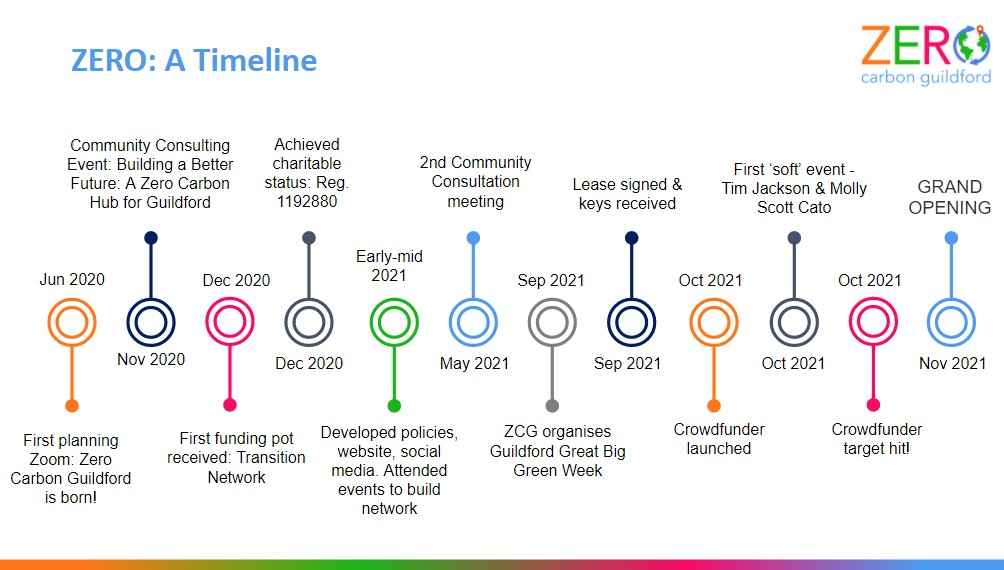
ZERO’s timeline: notable events in our climate hub journey
Below are the steps that were critical to getting ZERO open. They may not all work for you, and things can be far less complicated than they were for us, but for good governance, solid strategy, and (hopefully) longevity we found these to be essential.
Key things we learnt
- Do it your way Other similar groups across the UK, as well as the climate emergency centres, network can offer advice, but nobody else knows what’s right for your place and the people who live there. Make decisions based on what your community wants and needs.
- Don’t rush into anything It took us 18 months to find a building, but waiting was the right choice. It allowed us the time to get our strategy right, and then make well informed strategic decisions. Regardless of what’s going on around you, or what offers you get, if something doesn’t feel right with your aims, don’t rush into it in the hope it’ll pay off.
- What if you never get a building? Or what if the lease is ended after 6 months? Remember the project is about more than any one building – it’s about a commitment by your community to mitigate and adapt to the climate crisis. So, think about what you can do right now to begin building a community climate action plan, even before you have a building.
- Find your role – what your hub looks like will vary depending on the context in your town. What already exists locally? What can you help to expand? What doesn’t exist that you can get off the ground? A hub in Guildford may look wildly different to what might emerge in far more progressive Brighton or Bristol. In fact, it may be harder to find your niche where more projects already exist. Don’t reinvent the wheel, find the right place for your project in your community.
- Build a framework – Know your goals and build a framework early on – with input from your community. Gather a solid group of people committed to the project, from across a range of groups. This will help networking, but you’ll also get active people from other groups involved, and hopefully avoid the usual trap of lots of work falling on a few people. Once you have a framework built on community input, keep consulting until you think you have a clear strategy with a sense of how you will achieve your goals.
- Get Into The Doughnut – Doughnut Economics is a great place to start thinking about how your community can remodel how to live and work within planetary boundaries. it will help you understand the existing issues in your area, the potential solutions to them, and your place in a global crisis. All questions that Doughnut Economics Action Lab can help with!
1. Set your goals
Deciding what your objectives are is a critical part to this type of project. For us, this had two distinct phases. If you’re trying to build a community-led climate action plan, then you’ll need one particularly important ingredient – community input! Without that you’re just a bunch of people telling the rest of your community how to live – a tried and tested recipe for failure.
But you also need to get established enough to be a legitimate organisation and gain traction with your community. It can be tricky to figure out how to start moving forward while managing to set up a new organisation. So we decided on our long term objectives and built a framework we thought could achieve them, before fleshing these out with input from the Guildford community.
a) Decide on your overarching objectives. This could be a mission/vision statement, it could be official charitable objectives, or simply a clear list of goals You can view Zero Carbon Guildford’s charitable objectives here. It should be a high-level statement, which makes clear what you’re about, but which has lots of room to be flexible and adaptable.
b) Then build a loose framework. While your objectives should be clear and unchanging, your framework can be tweaked as you progress. It should be deliberately light and flexible, as it needs to be guided by ongoing community input. To generate buy-in from partners you’ll need a robust plan, but emphasise that you’ll tweak it depending on the direction the community takes your project.
2. Build your network
In our opinion, this is by far the most critical aspect of building a community-led climate action plan. There’s loads you can do without a building, but without being embedded in an expansive network focused on change you’re going to find yourself beyond capacity very quickly. It took over a year to even begin negotiating the lease for ZERO, and we used that time to build strong links across the borough and beyond, including pulling together 30ish events for Great Big Green Week to accelerate collaboration locally.
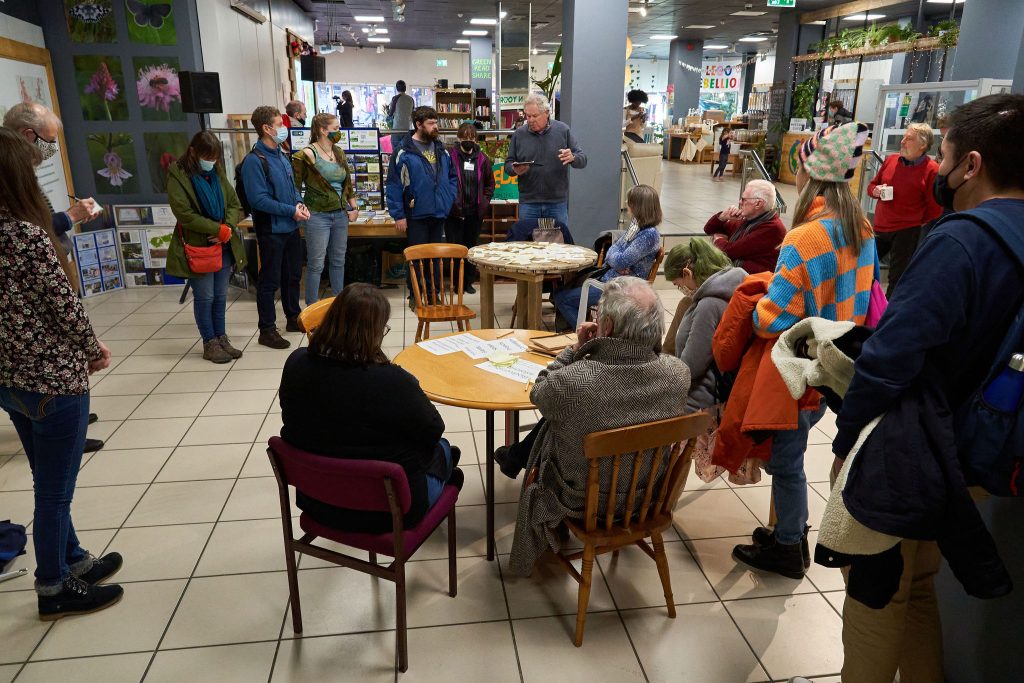
ZERO’s most recent community input session to help form the 2022 strategy.
Effective network building requires a lot of work and it’s ongoing. It’s sensible to set up a team around networking, so that contact is well distributed. Keep an up-to-date log of all networking conversations, so that anyone in the team can pick up where another has left off. It’ll save you effort down the line. We are currently having to distribute networking throughout subgroups, which is quite difficult, so getting it right to start with was a big lesson we learnt. Some people have a lot of contacts, make sure they loop in relevant people.
Climate Emergency Centres Network.
This is a support network which can offer invaluable advice. Lots of groups across the country are linked up via the CEC network – we’ve had over a dozen come visit ZERO to see us in action! All the groups are autonomous, but the network can support each group through resource- and experience-sharing, knowledge exchange and practical advice for overcoming obstacles. Regardless of your model, whether you’re already up and running, joining this network is critical to the success of these projects, and to averting the worst of the climate crisis. You can contact them here.
Even if you don’t need support, think about how you can support other groups. If we’re all trying different approaches and sharing our successes and failures, it makes the process of finding successful ways to remodel how we live and work easier and faster.
3. Decide on a structure
There are different sorts of legal entity you can form and register. The 3 main options are:
- CIO – Charity or Charitable Incorporated Organisation
- CIC – Community Interest Company
- Not-for-profit company limited by guarantee
We considered the first two options, and don’t know much about the third, so won’t talk about that! There are advantages to both CIOs and CICs.
Community Interest Companies are very quick to set up – you could do this in 24 hours. Speed can be extremely useful, because you can’t get a bank account without being a registered entity, and you can’t make funding bids without having a bank account!
You can set up as a CIC and register later as a CIO if you need to, although that can add extra difficulties as you need to transfer all the CICs assets into the new charity. Another advantage of a CIC is that as a company there are fewer regulations on how you generate funds through sales, whereas with a CIO everything you do must align with your charitable objectives.
Charitable Incorporated Organisation takes longer to set up than a CIC. For us it was about 4 months, but it can vary. The key thing for us, which will probably be very important to you too, is whether your local council grants full business rate relief to a CIC or only a CIO. For us it was the latter. However, we have long term plans which also played a role in our decision.
It’s important to research the limitations of each, and how they align with your goals, both short and long term.
4. How to find a Building
The obvious first step is hits the pavements of your town, village, or city, to see what empty buildings are out there! Buildings that have been vacant for a while are a good bet because there are loads of different people who will want them back in use – be it the landlord, council, or Business Improvement District, none of them want empty shopfronts.
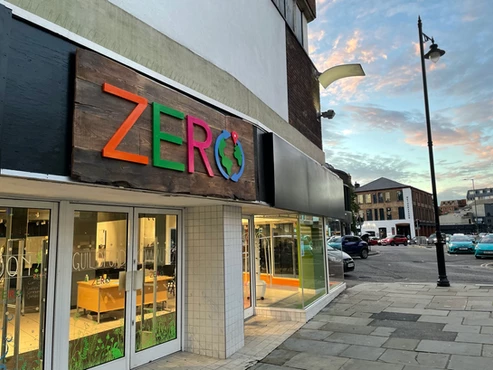
Zero Carbon Guildford found premises in a vacant high street store, a former New Look.
If you’ve found a potential site, you need to work out how to approach the owner.
a) Private landlord – Two options here. Either use Land Registry to find the owner, which gives you Title and details for £3 per search, and approach them directly. If this becomes a dead end use the contact details on the commercial agents’ board to arrange a viewing – at this stage you’re probably better off not saying you’re a charity or community group, just get through the door.
b) Find a council building. District/borough and county councils own a lot of buildings. They might be part of a portfolio (eg. the county’s pension fund), or part of the council’s operations, but there’s bound to be a building or two that you might be able to convince them to let you use. Most councils are struggling with community-facing climate engagement, and not only can this help improve their climate plans, but you can take a lot of difficult work on consumption, waste and behavioural change off their plates. So there’s good reasons for them to support you.
c) Use a pro. There are organisations who find buildings for ‘meanwhile use’ as their job. They can potentially save you a lot of time in your search. They can also be a last option if you’ve exhausted all other avenues. Here’s an an example of an agent who specialises in finding meanwhile leases for charities. The CEC network has useful links that can help you too, so if this is an option you’re exploring be sure to message them.
5. Negotiating A Lease
Negotiating a commercial lease can be extremely overwhelming. You might be able to do it if it’s a simple lease, but it can easily become complicated. Many legal firms will take on work for good causes pro bono (free of charge), as part of their social responsibility plans, which can in turn help them attract new clients.
We would have been completely lost without the services of Clyde & Co Guildford. The lease negotiation became more complex than expected, and they were extremely patient and helpful throughout. We cannot overstate how much stress it will save you to find a commercial property lawyer willing to help you.
Affording Premises
‘How can you afford to pay for this place?’ It’s one of the most common questions we get. The simple answer is that as a brand new organisation you probably can’t, at commercial rates. But this is why long-empty buildings should be your primary target. The landlord will have been paying business rates while the space has been empty. This could be tens, or even hundreds of thousands of pounds – a sting for any landlord. The power of your proposition is that you can save the landlord these costs, and could entice them to give you affordable rent.
When you move into a building the business rates will be your responsibility. But, as a charity and possibly a CIC you get a mandatory 80% relief on your rates. On top of that, it’s up to your council if they’ll give you a discretionary 20% on top of the mandatory relief. This means that you can be 100% relieved of business rates, meaning you pay £0.
This is why your choice of legal entity is extremely important, and why you must understand whether your council will grant you full rates relief as a CIC, or if you need to be a CIO, and should be an important consideration in your goals, because the 20% difference may depend on how closely you align with your council’s vision. You should be able to find a document on the council’s website which breaks down exactly who and what they will grant relief to. Find it and use it before you go too far.
NOTE: You will have to pay business rates up front when you move in – at least we did. You can’t apply for relief until you’re physically in the building. It feels like a bit of a gamble – albeit you should be confident from your research as to whether you’ll get the full 100%. Your BID might be able to give additional guidance. You’ll get a rebate if/when granted relief, but you should be prepared for this, and calculate in advance of a shock how much you’ll need in reserve to pay this, until they confirm your rate relief. See ‘Break Clause’ below for how you can protect your organisation in the event you don’t get relief you anticipated.
Lease types
There are different ways to get yourself into a building. Some climate hubs operate on a pop-up basis. This is a great solution for short-term projects, but does reign in your ambitious plans somewhat.
Most of us are working on a meanwhile lease – of which there are a few types. The type ZERO is operating on is a ‘full repairing lease’. For a company this would mean fixing the premises up to a nice shiny state, but as a charitable tenant you can add a clause to ensure you’re only expected to leave the building ‘in at least as good a state as you found it’. This is extremely important, because you don’t want to inadvertently spend your entire lease refurbishing and not building a climate action plan!
Break Clause
Your landlord is likely to want a break clause if your lease is longer than 6 months. Their goal is to let the building for profit, so you could be in a hoist by your own petard situation, where polishing up the space makes it more appealing to potential tenants.
You need to be prepared to move at short notice. Try to ensure you get at least 8 weeks’ notice in your lease. Make your displays mobile enough to move without damaging them or the fabric of the building. And remember, as disappointing as it’ll be when you have to leave your first home, the project is about way more than any one building – it’s about your community’s commitment to climate action.
A tenant’s break clause is also something you should add to the lease. As discussed above, you can’t be certain you’ll get full rates relief until you take possession of the premises. If you get lumbered with a bill for thousands, you’re probably going to bankrupt you’re organisation before you’ve done anything, so this is something you should strongly consider before you move forward.
6. Refurb
This is a key part to creating an inviting space – especially if you take on a building which has been empty for years, and has more than its share of holes and resident pigeons! ZERO tries really hard to ‘practise what we preach’, so we went to some effort to keep new materials to an absolute minimum. It creates more work (de-nailing, sanding, sorting out dodgy edges etc), but do it well and it demonstrates it’s perfectly possible to make great stuff from old materials.
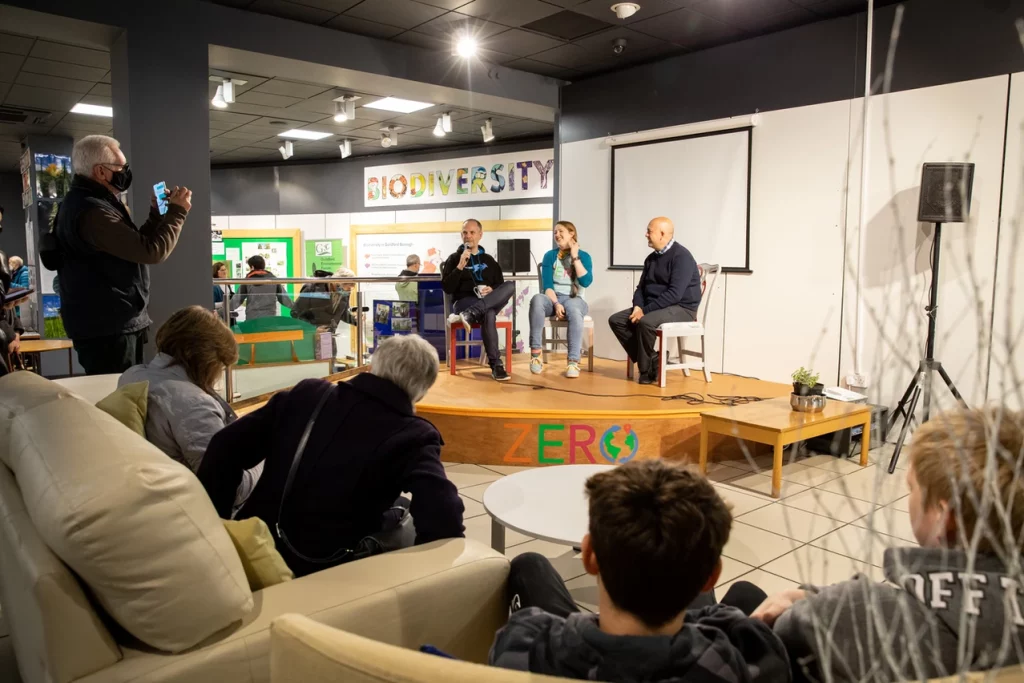
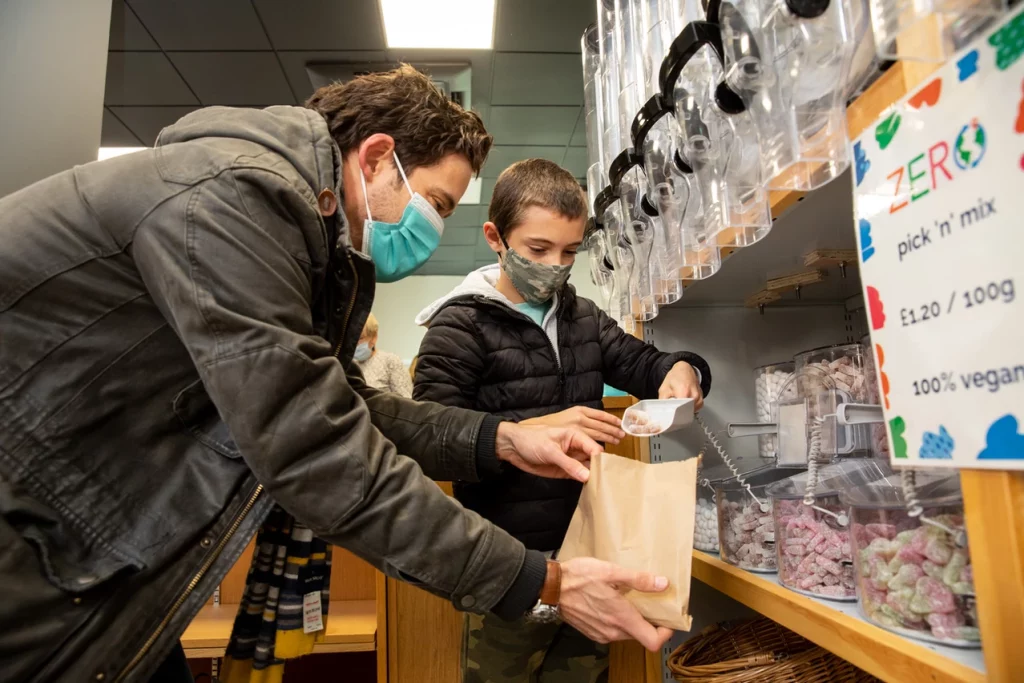
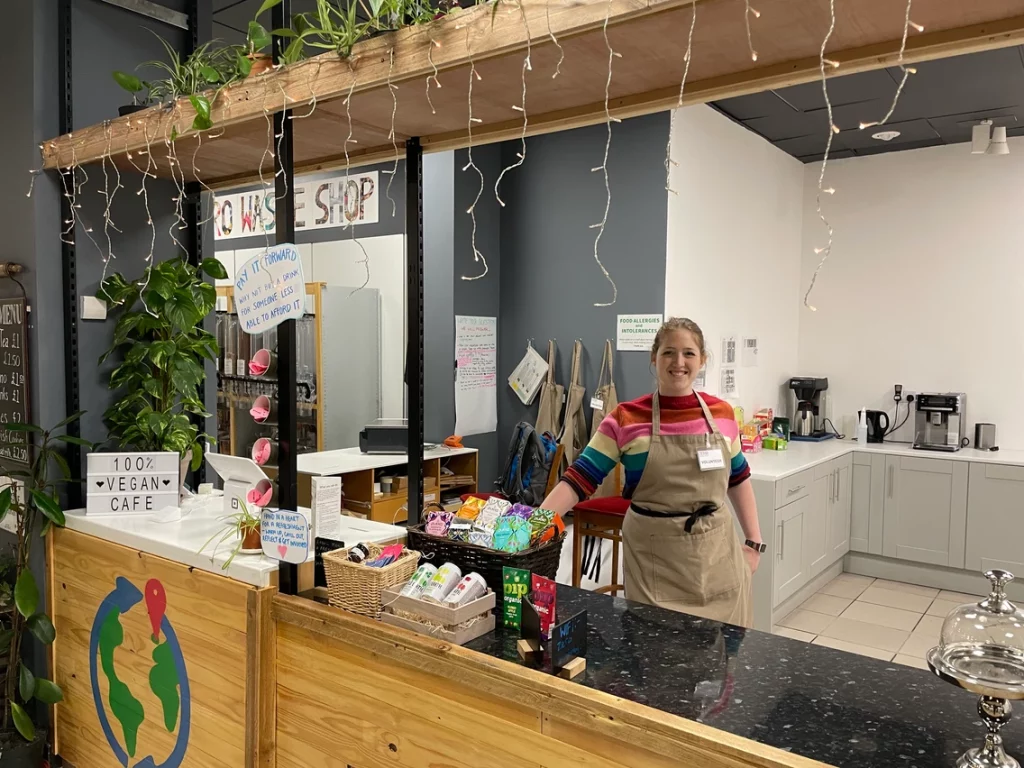
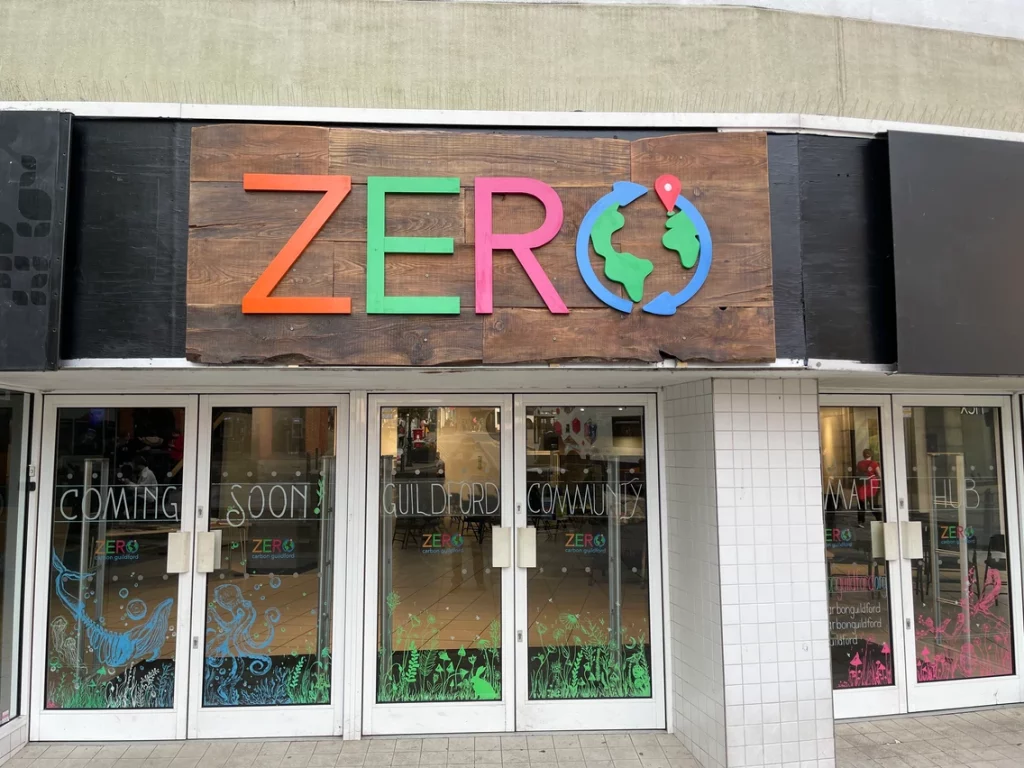
Our sign is larch donated by Norbury Park sawmill, and the letters are an old bed! We spent £30 on the whole cafe, on a worktop that was damaged and would have been landfilled. Our stage is large pallets clad in ply, of which only 2 sheets were new. Our zero waste shop is cabinets donated from Uni of Surrey’s sociology dept and clad in timber. Our Terracyle point is long pallets with MDF scrap shelves.
Materials
It may not be the case for everyone, but for us getting materials was surprisingly easy! It helped we had access to an electric van to collect things at short notice, and being a registered charity obviously lends some legitimacy to turning up at random and asking people for handouts!
The obvious places to start are Freecycle, Facebook Market Place, Next Door, all of which have things going for free. If you’ve got a university in your area they could be a massive help – the University Of Surrey gave us a HUGE amount of useful stuff.
Below are some of the places that really helped us:
- Howdens – donated an ex-display kitchen
- University Of Surrey – racking for Zero Waste Shop and loads of furniture
- Selco – gave us a great discount on timber, currently very pricey
- Fully Charged Guildford – the local electric bike shop moved premises into a former kitchen display shop. They donated the old display walls the demo kitchen were fixed to, which we turned into an accessible gender neutral toilet.
- Ockham Parish Hall – were moving and gave us crockery, tables and an urn
Other Sources: Screwfix, Jewson, and other builders merchants have foundations or give out grants for refurb. We were rejected from both, but they’re worth a try.
Pallets can be a lifesaver. They’re treated wood, so you can’t use them near food, but we used pallets that would have been going to landfill to create a ton of cool stuff – a stage (pallets clad with ply), a Terracycle station, loads of signs, even a Christmas tree!
Art
There’s often a crossover between environmentalists and artists, so you probably have a couple of good artists in your group. Our chair’s 12-year-old did our window art! If you’ve got anyone who’s handy with chalkpens, paint brush or spray can, this is a brilliant low cost and effort way to make a space look great.
Labour
The more expansive your network, the easier it’s going to be to find experienced tradespeople who might be kind enough to donate a bit of time. The amount of time and effort needed to get the refurb done will obviously depend on the state of your premises, but given you’re likely targeting empty buildings it could be in a bit of a state!
You’ll likely want to build a number of display and exhibits, maybe an accessible loo, a small stage, lots of signage etc. Our list never gets any shorter. Put semi/skilled volunteers on the most pressing and difficult things first. Anyone can figure out how to hang pictures or make a frame, but carpentry, electrics, and plumbing can be beyond the average DIYer.
It took about 7-8 weeks to get ZERO to an acceptable state for opening. We did run events before this, with the rest of the space cordoned off. That was two floors, inspection holes filled, walls painted, displays made, accessible loo built, cafe constructed, zero waste shop built, etc
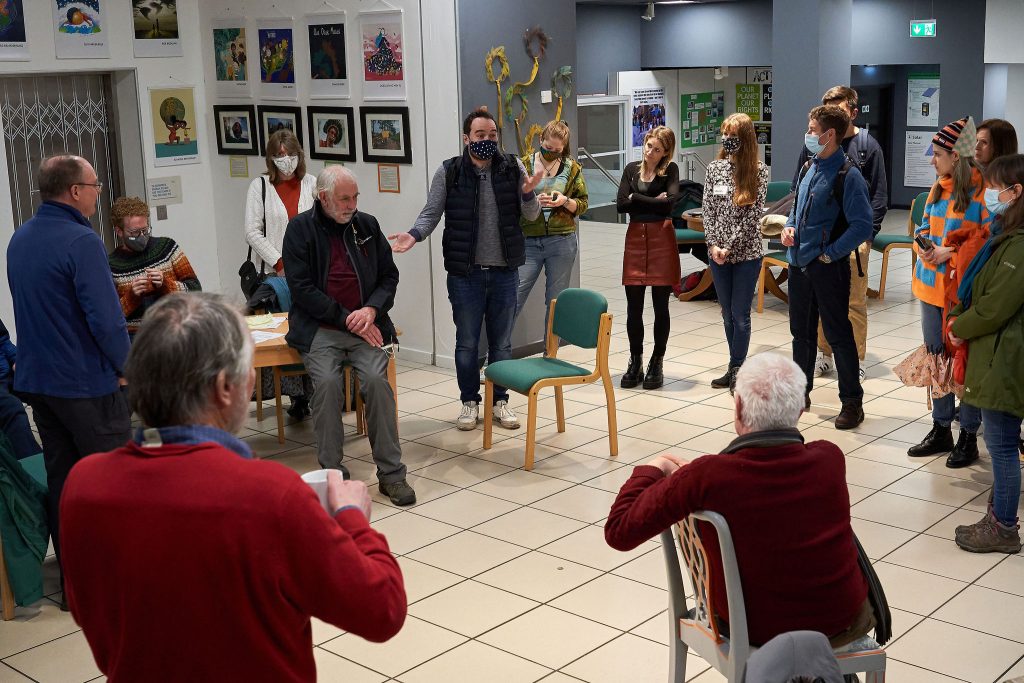
ZERO’s volunteers worked hard to create an inviting space that people would want to come to.
7. Volunteers
Timing is key when it comes to volunteers. You need to hit the ground running, so it’s tempting to start recruiting volunteers when you’re getting a plan together. But if you start trying to sign up volunteers before they’ve got anything to sink their teeth into then they’ll almost certainly lose them.
The exception to this is skilled labour. In an ideal world, you’d want to book tradespeople about 2 months in advance, to start on the day you get the keys. In reality, this will be almost impossible to plan. So having one or two really handy people who can spare a couple of weeks each, and can be available at short notice is probably your best bet. They can get the bulk of the work done, and if necessary leave the parts they can’t do to a trained individual. Gas and electrics should never be taken on by someone without the relevant qualifications.
The type of volunteers you need will change around your launch date, so you need to think about both parts of the project. Once you get the keys you’re going to want people to do cleaning, painting, setting up displays, reaching out to local news outlets etc.
Then once you launch, you’re going to need people to run the facility, organise events, maintain the website, deal with building rates, accounts, invoicing etc. So it’s key to have a timeline for your first couple of years and know exactly what roles are going to be most important to keep you open, and ideally pro-active rather than just treading water.
We had a ‘core group’ of about 15-20 people until about three weeks before we got the keys, then we started reaching out to more general volunteers. Since opening we have dropped the term ‘core group’, as we’re all part of the ZERO community, and it felt unnecessary to divide people who are actually all volunteers.
8. Essential Help
Nobody is more important than anyone else when you’re building a community climate action plan. However, there are some roles which you might not think about to start with, but quickly become extremely important – and at times a full-time job! These will obviously be dependent on your objectives and set up, but these are some that have been critical for us:
Tech person: There are a LOT of ways that a highly competent tech person can make your life easier. Aside from standard operational stuff like creating and managing your website, sending newsletters, etc, you’ll likely need to set up various different things that a techy brain will save you hours of frustration with. These might be crowdfunding platforms, online donations or in-person tap pads.
One of ZERO’s trustees is an engineer and loves fiddling with tech. He built us a Climate Clock for our window, and turned a piece of ply into an interactive wall which was a prototype collaboration with The Jump (which any group can recreate and build in their own local solutions). He also managed to get second hand scales and till equipment properly functioning – something which, left to the rest of us, would almost certainly have ended up in pieces on the floor.
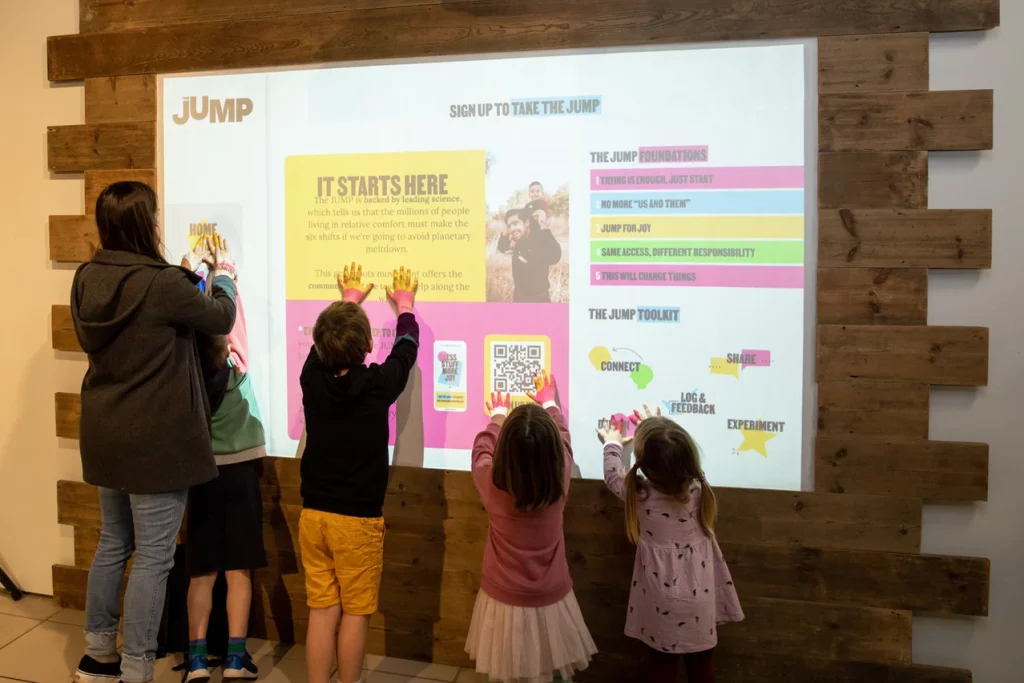
ZERO’s interactive wall is based on research by ARUP and The Jump, and incorporates local solutions to 6 main shifts we can make to lower an area’s emissions. It’s jointed 12mm ply, with a surround made of floorboards salvaged from a neighbour’s skip, and magnetic paint sensors which make it touchscreen!
Building / Facilities Manager: Running a building takes a huge amount of effort. Once you’re open, it does get easier, but getting to that point can be a challenge. We landed on our feet in finding someone to take this on during a career break – and it became evident very quickly this was a role in itself, and way more than we had anticipated. Working out how to turn on the light with no signs of light switches was our first challenge. Later there are bin collections, food hygiene, fire safety & inspections, lift and air con inspections and a whole host of other things to think about.
Volunteer Manager: If you are successful in creating buzz around your project, you’ll get a lot of interest from volunteers. Someone needs to stay on top of enquiries, respond to emails, meet volunteers and bring them on board. Again, we lucked out in that the former manager of a local charity had just retired, and stepped in as our volunteer manager. You ideally want to use a volunteer management platform to make their life easier. We use Better Impact which allows us to schedule shifts.
Your county probably has voluntary support charities and you want to link up with them early doors. Not only will they have a wealth of experience in legal entities, constitutions and more, they are paid to support local charities. So make use of their services! They can likely also help you find volunteers.
Finance Officer: You need someone to handle your organisation’s finances. If you’re a charity this needs to be someone with experience, preferably in charity finance and regulations. We are currently discovering that it’s too much work for one person. Speaking from experience, it’s great if you can have someone to do day-to-day accounts, and someone for bigger picture stuff. Otherwise the workload becomes overwhelming.
9. Policies
There’s no sugar-coating this: writing and signing off policies is painful. We held three sessions just getting them signed off, which lasted hours, on top of the time writing them. We called the sessions PolicyFest, but giving it a fun name did not make it any more enjoyable.
Thankfully, you don’t need to start from scratch. There’s loads of resources available to help, such as Small Charity Support. Some of the existing CECs in the UK have contributed their policies to a pooled resource. If you link up with the Climate Emergency Centres network they can potentially provide example policies.
Assign someone to be responsible for a particular policy to spread the load, and make sure you keep it updated when there are policy changes.
10. Why Start A Climate Hub?
Clearly this is all a lot of effort – so why are climate emergency centres so needed? If you’re reading this, you probably don’t need a lesson on the severity and scale of what awaits us if we don’t take immediate and ambitious action on the climate emergency. But it can feel completely overwhelming to even think about how to avoid or prepare for this. Climate hubs can help in a number of ways.
Resilience & Adaptation
If can carry on as we’re going, heading for 3-4C warming, which will be catastrophic for the majority of life on earth, there’s a real risk of collapse of society as we know it. Or, we can begin remodelling how we live and work within planetary boundaries, whilst ensuring that we meet basic human needs. Either way, life as we currently know is done for. Climate Emergency Centres can be the focal point for exploring and remodelling how our communities and economies operate.
Community Cohesion
Unity in our communities is going to be absolutely critical if we’re going to tackle the challenges we face. We saw this in the early stages of Covid with mutual aid networks springing up. Climate hubs provide a space for people to meet their community in person, removing the faceless arguing of social media, and helping to remove ideology from the equation. The one thing you all share in common is that you’re part of the same community, you’ll all face similar impacts of climate breakdown, and you all care about your town and community.
Take Action
More and more people are realising that the way we are living isn’t working for us or the planet. Community hubs create spaces for people to explore what they can do, now, today, to change the course of our communities, without having to wait for others to act.
In the face of financial uncertainly, division, inequality and environmental disaster, we can start to build new structures which benefit our community, and acknowledge our place and impact on the world and the crises we face. Of course, this isn’t easy. But it’s key not only to averting a planetary disaster, but also to increasing the wellbeing and happiness in our towns, allowing us to place the things that the community truly values at the centre of our new models.
There are of course many other reasons that an ecohub or climate emergency centre can be hugely beneficial to your area. You’ll decide what.
11. Wrapping Up
Breaking it all down like this might make it seem overwhelming to get this project off the ground. And at times it can be – which is why a solid plan and a good network are key components. But it’s also a lot of fun! We had some stressful times, but I don’t think any of our team regret anything now we’re at this stage. This is just the ZERO experience, there are lots of groups approaching this sort of project differently, so you may one of their journeys works better for you.
The irony of getting a climate hub open is that that’s actually the easy part! Once you’re open, the real work begins of figuring out how to unite your community around a fair and ambitious climate plan for your area. There’s no pretending this will be easy just because you now have a space focused on climate. But this can be a huge step forward in reaching past the ‘climate bubble’, and engaging all parts of our community, across, age social and political spectrums, in a plan to protect your community on a changing planet.
Big thanks to the team at Zero Carbon Guildford for sharing their guide to starting a community-led climate hub. You’ll find lots more information on their website, and follow them on Facebook and Twitter for updates.





